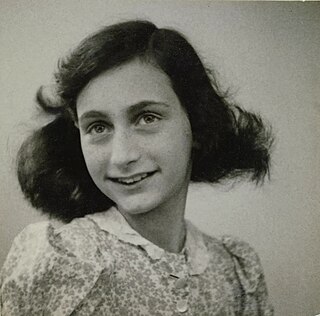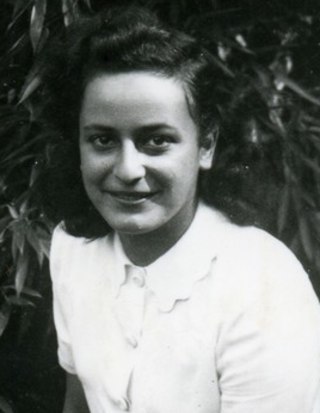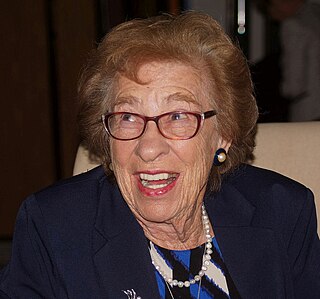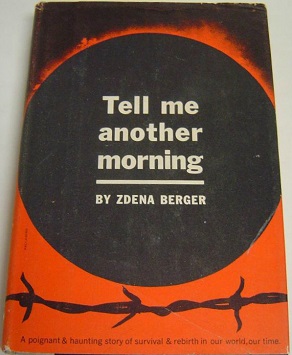
Otto Heinrich Frank was the father of Anne Frank. He edited and published the first edition of her diary in 1947 and advised on its later theatrical and cinematic adaptations. In the 1950s and 60s he established European charities in his daughter's name and founded the trust which preserved his family's wartime hiding place, the Anne Frank House, in Amsterdam.
Margot Elisabeth Dreschel, also spelled Drechsler, or Drexler, was a prison guard at Nazi concentration camps during World War II. For her role in the Holocaust, she was sentenced to death and hanged.

Annelies MarieFrank was a German-born Jewish girl who kept a diary in which she documented life in hiding under Nazi persecution during the German occupation of the Netherlands. She is a celebrated diarist who described everyday life from her family hiding place in an Amsterdam attic. One of the most-discussed Jewish victims of the Holocaust, she gained fame posthumously with the 1947 publication of The Diary of a Young Girl, in which she documents her life in hiding from 1942 to 1944 — it is one of the world's best-known books and has been the basis for several plays and films.

The Diary of a Young Girl, commonly referred to as The Diary of Anne Frank, is a book of the writings from the Dutch-language diary kept by Anne Frank while she was in hiding for two years with her family during the Nazi occupation of the Netherlands. The family was apprehended in 1944, and Anne Frank died of typhus in the Bergen-Belsen concentration camp in 1945. Anne's diaries were retrieved by Miep Gies and Bep Voskuijl. Miep gave them to Anne's father, Otto Frank, the family's only survivor, just after the Second World War was over.

Edith Frank was the mother of Holocaust diarist Anne Frank and her older sister Margot. After the family were discovered in hiding in Amsterdam during the German occupation, she was transported to Auschwitz-Birkenau concentration camp.
The Holocaust has been a prominent subject of art and literature throughout the second half of the twentieth century. There is a wide range of ways–including dance, film, literature, music, and television–in which the Holocaust has been represented in the arts and popular culture.

The Attic: The Hiding of Anne Frank is a 1988 television film directed by John Erman. It is based on Miep Gies's 1988 book Anne Frank Remembered. The film was broadcast as part of an ad hoc network, Kraft Golden Showcase Network. Playwright William Hanley received an Emmy for his script.
Miklos Samual Kanitz was a Hungarian-Canadian Holocaust survivor living in Saskatoon, Saskatchewan. He narrowly escaped being transported to the German death camp at Auschwitz in June 1944 at the age of six, because a neighbor, whose son was a member of the Hungarian fascist Arrow Cross Party, risked her life to hide Kanitz, his mother, and his brother in her potato cellar for seven months until the end of the war.
Cherie Bennett is an American novelist, actress, director, playwright, newspaper columnist, singer, and television writer on the CBS Daytime soap opera The Young and the Restless.
Howard Jeffrey Gottesfeld is an American novelist, playwright, and screen and television writer. In recent years he has focused on writing texts for picture books for children, grades two and up.

Rut "Rutka" Laskier was a Jewish Polish diarist who is best known for her 1943 diary chronicling the three months of her life during the Holocaust in Poland. She was murdered at Auschwitz concentration camp in 1943 at the age of fourteen. Her manuscript, authenticated by Holocaust scholars and survivors, was published in the Polish language in early 2006. English and Hebrew translations were released the following year. It has been compared to the diary of Anne Frank.

Marion's Triumph is a 2003 documentary film that tells the story of Marion Blumenthal Lazan, a child Holocaust survivor, who recounts her painful childhood memories in order to preserve history. The film combines rare historic footage, animated flashbacks, and family photographs to illustrate the horrors she experienced. It is narrated by Debra Messing.

Hélène Berr was a French woman of Jewish ancestry and faith, who documented her life in a diary during the time of Nazi occupation of France. In France she is considered to be a "French Anne Frank". She died from typhus during an epidemic of the disease in Bergen-Belsen concentration camp that also killed Anne Frank and her sister Margot.

Susanne "Sanne" Ledermann was a German Jewish girl who was murdered in the Auschwitz concentration camp. She was best-known for her friendship with sisters Anne and Margot Frank.

Eva Schloss is an Austrian-English Holocaust survivor, memoirist and stepdaughter of Otto Frank, the father of Margot and diarist Anne Frank. Schloss speaks widely of her family's experiences during the Holocaust and is a participant in the USC Shoah Foundation's Visual History Archive project to record video answers to be used in educational tools.

Tell Me Another Morning is an autobiographical novel by Zdena Berger, a survivor of Holocaust camps at Theresienstadt, Auschwitz and Bergen-Belsen. Berger began writing the book in 1955 after coming to North America and in 1961 she published the work through Harper & Brothers. The work went out of print shortly thereafter but was reissued in 2007 through Paris Press. The book depicts the experiences of Tania Andersova, a teenage girl who is taken away to the Nazi concentration camps during the Holocaust.
Rywka Lipszyc was a Polish-born Jewish diarist and Holocaust survivor. She was deported to Auschwitz-Birkenau concentration camp followed by a transfer to Gross-Rosen and forced labor at its subcamp in Christianstadt. She was then taken on a death march to Bergen-Belsen, and was liberated there in April 1945. Too ill to be evacuated, she was transferred to a hospital at Niendorf, where the record of her life ended.
Renia Spiegel was a Jewish Polish diarist who was killed during World War II in the Holocaust.

Eva Heyman was a Jewish girl from Oradea. She began keeping a diary in 1944 during the German occupation of Hungary. Published under the name The Diary of Eva Heyman, her diary has been compared to The Diary of a Young Girl by Anne Frank. She discusses the extreme deterioration of the circumstances the Jewish community faced in the city, offering a detailed account of the increasingly restrictive anti-Jewish laws, the psychological anguish and despair, the loss of their rights and liberties and the confiscation of property they endured. Heyman was 13 years old when she and her grandparents were murdered in the Holocaust.












